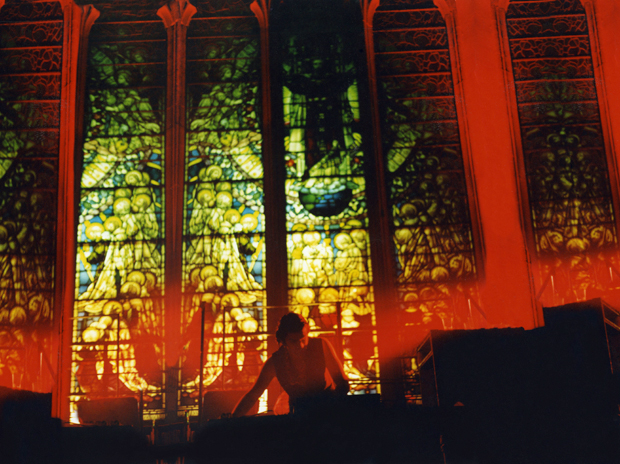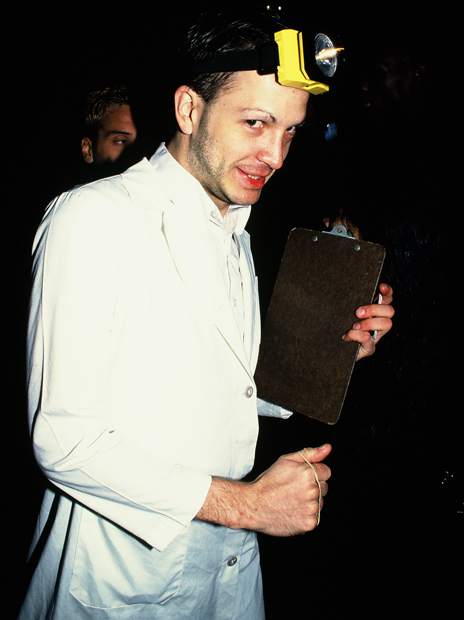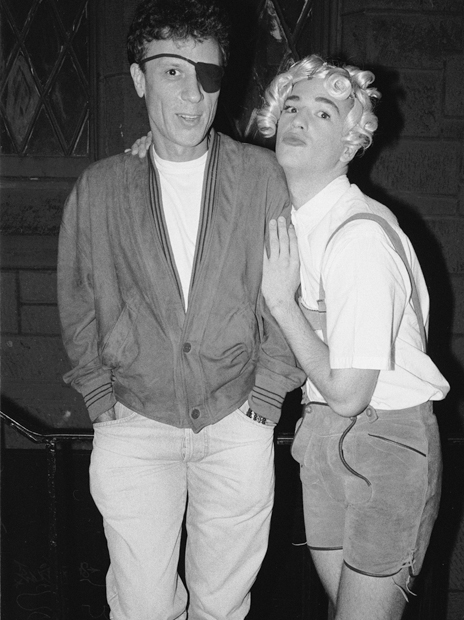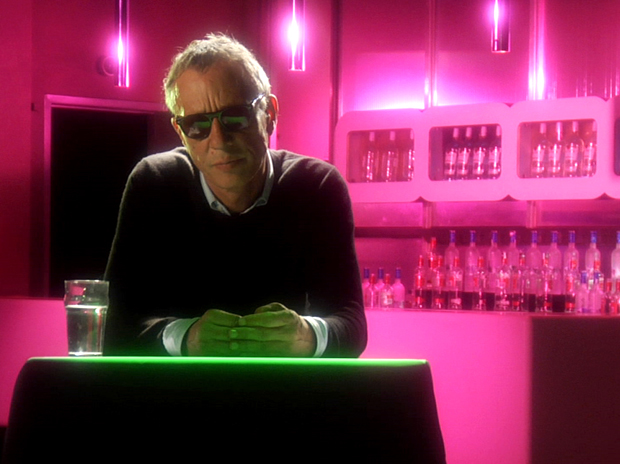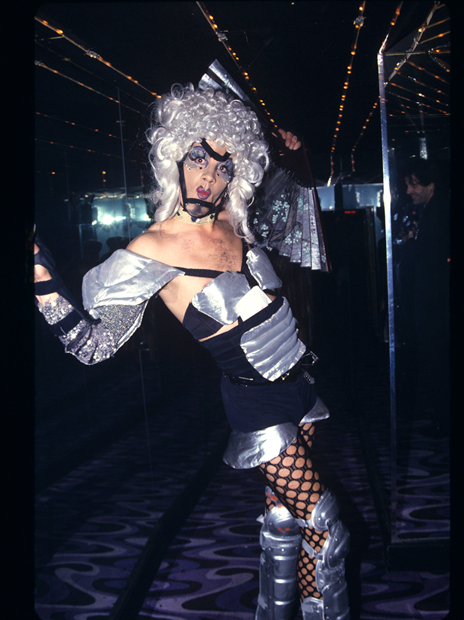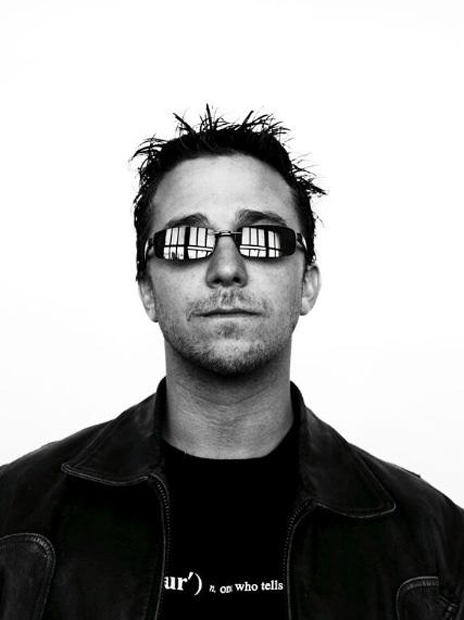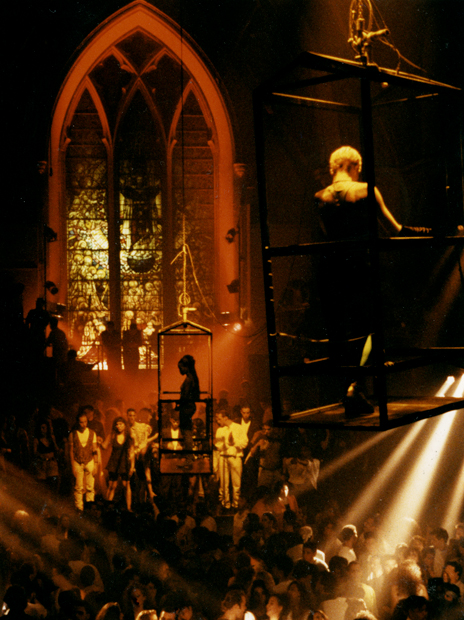I'm bored with that line. I never use it anymore. My new line is “In 15 minutes everybody will be famous”.
- Andy Warhol
Andy Warhol, the god-like genius of pop art who in November 1983 hosted the opening night of the Limelight club in New York, had presciently foreseen the democratization of fame in his now iconic one line manifesto in 1968, later riffing on his own credo out of frustration with its journey into cliché.
The Limelight spun that riff into a gyrating, vinyl clad, gender-bending, genre-hopping, and rhythm-soaked reality. It literally hummed with the electricity flowing from the sense that everyone in that wild church of emancipated hedonism was on the cusp of leaping with simultaneous and euphoric abandon through the looking glass of fame - just being there was celebrity itself.
The man behind the club, who played foster father to the sheer creative energy of the multiple scenes to which it played host, was Peter Gatien. Crowned by the New York Post in his early 1990s heyday as the “King of New York clubs”, this nightlife visionary was at that time owner of the biggest and most influential nightspots in the city - the Palladium, the Tunnel, Club USA and the Limelight.
Having cut his teeth in his native Canada with a country and western bar turned rock club, he arrived in America chasing a dream inspired by a newspaper report about a bankrupt nightclub in Hollywood, Florida. Like all visionaries, Gatien made his dream a reality, by the late 1970s ha had transformed the venue into the Limelight - the first of one of the most avant-garde club chains in history.
Gatien added further outposts to the Limelight empire in Atlanta and Chicago by converting the former homes of both the Harlequin Dinner Theatre and the magnificent Chicago Historical Society into exquisitely designed super-clubs that made innovative use of their unusual settings. However, it was when Gatien seized the opportunity of buying one of Manhattan’s sacred architectural aristocrats that the world really sat up and took notice of this intuitively fabulous dreamer.
Located at the historically well-to-do address of Avenue of the Americas and West 20th Street in the Flatiron District, The Church of the Holy Communion and Buildings had boasted the cream of New York society in its congregation - including Cornelius Vanderbilt, Jay Gould and John Jacob Astor. It was constructed in 1846 by Richard Upjohn, one of the era’s greatest American architects, a still-revered example of the grand Gothic Revival style churches for which he became most famous. Featuring brownstone blocks randomly placed in an asymmetric pattern - the first to do so - and designed to resemble a medieval parish church, it was regarded by many as one of the most architecturally influential American buildings of the century.
By the time this sanctified masterpiece of a bygone age fell into Peter Gatien’s lap, the neighbourhood was semi-derelict as a result of the economic stagnation in 1970s New York, The Church of the Holy Communion having long been deconsecrated. While Gatien also created his London Limelight club from the shell of a former church on Shaftesbury Avenue, it was his New York temple to night-time pursuits that became his crowning glory.
Gatien stripped the beautiful old structure of its sacred context - distorting the Gothic finery with a funhouse mirror, placing bars lined with expensive imported spirits (alcoholic as opposed to celestial) next to the marble crypts, and turning the hushed reverence of the chapel into the riotous frivolity of the VIP lounge. In so doing, he and revered contemporary design luminary Ari Bahat created pop art of which Warhol would have approved.
The warren of stairways and corridors formed an intricate network of interconnected lounges and dance floors which were designed by the cream of the creative industries of the day. One such example was the VIP room created by Swiss surrealist painter and sculptor H. R. Giger, whose dystopian imagery and groundbreaking designs were heavily influential in the early 1980s and won him an Oscar for his creation of the terrifying Alien in the eponymous film.
Into this extraordinary space he had built, with the transgressive thrill of what became its trademark go-go cages suspended enticingly above the dancefloor, Gatien poured perhaps the most dynamically diverse collection of revellers ever assembled in clubland.
The Limelight made an immediate impact with its star-studded opening party, where supermodels and elite architects danced the night away with artists and movie stars, all the while being snapped and interviewed by the glamour press.
Offering cutting edge music in an expansive world-class venue (it boasted a 2,500 capacity), and imbued with the unique creativity of the people who had helped create it, the Limelight drew an extraordinary mix of people, from A-list celebrities to weekend thrill-seekers. From Prince strutting his stuff on the dance floor behind the protective wall of his entourage, to Mick Jagger’s 40th Birthday, which was hosted by Gatien, and the gay community and the fashion crowd who flocked to the ever popular gay nights, every clique was welcome.
Gatien’s genius for the organic and the eclectic can be seen in the dizzying course the Limelight charted through New York’s myriad scenes and scenesters for nearly fifteen years - which seems like a lifetime in the ever changing and dichotomous world of the young and their music and fashion.
Pearl Jam, Guns N’ Roses, Smashing Pumpkins and Nine Inch Nails - bands who would go on to stadium-filling superstardom - broke into the public consciousness on stage at the Limelight, while Gatien invited DJs from England, such superstar DJ Paul Oakenfold - to play the first techno heard in New York. The Sunday night hip-hop event drew the biggest contemporary names in New York’s truly modern music art form, including Funkmaster Flex, Mary J. Blige, Jay-Z and even Puffy.
No matter who you were, either dressed up to the nines or down to the bare essentials, the look was everything. The Limelight’s reputation for the outrageous and the extreme intensified as its fame grew, and it spawned its own scene - the Club Kids. This group of wildly creative hedonists, vividly attired in a mixture of baby-doll innocence and S&M tinged eroticism, were drawn to the club’s cutting edge techno and the powerful do-it-yourself creativity that Gatien radiated. Guided by James St. James, an avant-garde star of New York’s flamboyant party folklore, figurehead Michael Alig’s instinctive talent for truly innovative scene-stealing promotion made the Club Kids the talk of the town and stars of many of their number - such as RuPaul, Amanda Lepore and the outrageous fashion designers Heatherette - Richie Rich and Traver Rains.
While embracing new music and sub-cultures was Gatien’s gift it was also to be his curse as the Club Kids’ spell of provocative appearances on talk shows as the modern face of teenage rebellion led to intense scrutiny being placed on Gatien and his club. The Limelight was closed by the authorities in 1997 and, while it reopened again soon after and continued under a series of guises - most recently the Avalon, it was never to completely recover its glory years and shut its doors finally in 2007. This extraordinary building, full to the rafters with New York history, is now a Chelsea shopping mall.
While Peter Gatien remains living in his native Canada, currently exploring various new and ambitious projects in the world of international nightlife, his incredible story and that of the Limelight are now hot property in New York once more, with the release of “Limelight”. Produced by his daughter Jen, Alfred Spellman and Dave Berlin, and directed by Billy Corben, the fantastic documentary uses candid interviews and exclusive footage to chart the spectacular times of both the club and its flamboyant owner.
Gatien’s reign as New York’s King of clubland was founded on chaos, on the forces of positivity and spontaneous creativity that swirl around youth at play - a foundation as mercurial and impermanent as it is powerful and which had given him the impulse to fly so close to the sun.
- Benjamin Stewart
Limelight
Address: 656 Avenue of the Americas
New York, 10011
Limelight Documentary
Website: www.rakontour.com
www.magpictures.com/limelight/
Photo Credit: Courtesy of Magnolia Pictures
- Andy Warhol
Andy Warhol, the god-like genius of pop art who in November 1983 hosted the opening night of the Limelight club in New York, had presciently foreseen the democratization of fame in his now iconic one line manifesto in 1968, later riffing on his own credo out of frustration with its journey into cliché.
The Limelight spun that riff into a gyrating, vinyl clad, gender-bending, genre-hopping, and rhythm-soaked reality. It literally hummed with the electricity flowing from the sense that everyone in that wild church of emancipated hedonism was on the cusp of leaping with simultaneous and euphoric abandon through the looking glass of fame - just being there was celebrity itself.
The man behind the club, who played foster father to the sheer creative energy of the multiple scenes to which it played host, was Peter Gatien. Crowned by the New York Post in his early 1990s heyday as the “King of New York clubs”, this nightlife visionary was at that time owner of the biggest and most influential nightspots in the city - the Palladium, the Tunnel, Club USA and the Limelight.
Having cut his teeth in his native Canada with a country and western bar turned rock club, he arrived in America chasing a dream inspired by a newspaper report about a bankrupt nightclub in Hollywood, Florida. Like all visionaries, Gatien made his dream a reality, by the late 1970s ha had transformed the venue into the Limelight - the first of one of the most avant-garde club chains in history.
Gatien added further outposts to the Limelight empire in Atlanta and Chicago by converting the former homes of both the Harlequin Dinner Theatre and the magnificent Chicago Historical Society into exquisitely designed super-clubs that made innovative use of their unusual settings. However, it was when Gatien seized the opportunity of buying one of Manhattan’s sacred architectural aristocrats that the world really sat up and took notice of this intuitively fabulous dreamer.
Located at the historically well-to-do address of Avenue of the Americas and West 20th Street in the Flatiron District, The Church of the Holy Communion and Buildings had boasted the cream of New York society in its congregation - including Cornelius Vanderbilt, Jay Gould and John Jacob Astor. It was constructed in 1846 by Richard Upjohn, one of the era’s greatest American architects, a still-revered example of the grand Gothic Revival style churches for which he became most famous. Featuring brownstone blocks randomly placed in an asymmetric pattern - the first to do so - and designed to resemble a medieval parish church, it was regarded by many as one of the most architecturally influential American buildings of the century.
By the time this sanctified masterpiece of a bygone age fell into Peter Gatien’s lap, the neighbourhood was semi-derelict as a result of the economic stagnation in 1970s New York, The Church of the Holy Communion having long been deconsecrated. While Gatien also created his London Limelight club from the shell of a former church on Shaftesbury Avenue, it was his New York temple to night-time pursuits that became his crowning glory.
Gatien stripped the beautiful old structure of its sacred context - distorting the Gothic finery with a funhouse mirror, placing bars lined with expensive imported spirits (alcoholic as opposed to celestial) next to the marble crypts, and turning the hushed reverence of the chapel into the riotous frivolity of the VIP lounge. In so doing, he and revered contemporary design luminary Ari Bahat created pop art of which Warhol would have approved.
The warren of stairways and corridors formed an intricate network of interconnected lounges and dance floors which were designed by the cream of the creative industries of the day. One such example was the VIP room created by Swiss surrealist painter and sculptor H. R. Giger, whose dystopian imagery and groundbreaking designs were heavily influential in the early 1980s and won him an Oscar for his creation of the terrifying Alien in the eponymous film.
Into this extraordinary space he had built, with the transgressive thrill of what became its trademark go-go cages suspended enticingly above the dancefloor, Gatien poured perhaps the most dynamically diverse collection of revellers ever assembled in clubland.
The Limelight made an immediate impact with its star-studded opening party, where supermodels and elite architects danced the night away with artists and movie stars, all the while being snapped and interviewed by the glamour press.
Offering cutting edge music in an expansive world-class venue (it boasted a 2,500 capacity), and imbued with the unique creativity of the people who had helped create it, the Limelight drew an extraordinary mix of people, from A-list celebrities to weekend thrill-seekers. From Prince strutting his stuff on the dance floor behind the protective wall of his entourage, to Mick Jagger’s 40th Birthday, which was hosted by Gatien, and the gay community and the fashion crowd who flocked to the ever popular gay nights, every clique was welcome.
Gatien’s genius for the organic and the eclectic can be seen in the dizzying course the Limelight charted through New York’s myriad scenes and scenesters for nearly fifteen years - which seems like a lifetime in the ever changing and dichotomous world of the young and their music and fashion.
Pearl Jam, Guns N’ Roses, Smashing Pumpkins and Nine Inch Nails - bands who would go on to stadium-filling superstardom - broke into the public consciousness on stage at the Limelight, while Gatien invited DJs from England, such superstar DJ Paul Oakenfold - to play the first techno heard in New York. The Sunday night hip-hop event drew the biggest contemporary names in New York’s truly modern music art form, including Funkmaster Flex, Mary J. Blige, Jay-Z and even Puffy.
No matter who you were, either dressed up to the nines or down to the bare essentials, the look was everything. The Limelight’s reputation for the outrageous and the extreme intensified as its fame grew, and it spawned its own scene - the Club Kids. This group of wildly creative hedonists, vividly attired in a mixture of baby-doll innocence and S&M tinged eroticism, were drawn to the club’s cutting edge techno and the powerful do-it-yourself creativity that Gatien radiated. Guided by James St. James, an avant-garde star of New York’s flamboyant party folklore, figurehead Michael Alig’s instinctive talent for truly innovative scene-stealing promotion made the Club Kids the talk of the town and stars of many of their number - such as RuPaul, Amanda Lepore and the outrageous fashion designers Heatherette - Richie Rich and Traver Rains.
While embracing new music and sub-cultures was Gatien’s gift it was also to be his curse as the Club Kids’ spell of provocative appearances on talk shows as the modern face of teenage rebellion led to intense scrutiny being placed on Gatien and his club. The Limelight was closed by the authorities in 1997 and, while it reopened again soon after and continued under a series of guises - most recently the Avalon, it was never to completely recover its glory years and shut its doors finally in 2007. This extraordinary building, full to the rafters with New York history, is now a Chelsea shopping mall.
While Peter Gatien remains living in his native Canada, currently exploring various new and ambitious projects in the world of international nightlife, his incredible story and that of the Limelight are now hot property in New York once more, with the release of “Limelight”. Produced by his daughter Jen, Alfred Spellman and Dave Berlin, and directed by Billy Corben, the fantastic documentary uses candid interviews and exclusive footage to chart the spectacular times of both the club and its flamboyant owner.
Gatien’s reign as New York’s King of clubland was founded on chaos, on the forces of positivity and spontaneous creativity that swirl around youth at play - a foundation as mercurial and impermanent as it is powerful and which had given him the impulse to fly so close to the sun.
- Benjamin Stewart
Limelight
Address: 656 Avenue of the Americas
New York, 10011
Limelight Documentary
Website: www.rakontour.com
www.magpictures.com/limelight/
Photo Credit: Courtesy of Magnolia Pictures

Limelight - Peter Gatien,








